J@pan Inc -- Is Your Building Green?
Environmentally friendly office buildings in Tokyo.
By Dylan Robertson
Five years ago, a global facilities manager for a major corporation called me to discuss the relocation of their Tokyo office. After describing the criteria for their desired property, he added, "The building must be environmentally friendly in every way possible. All things green help our corporate image - even the office buildings we occupy." This was the first of many such requests.
Sophisticated tenants in Japan are increasingly showing a preference for buildings that incorporate environmentally friendly materials and technologies. So nowadays developers must also incorporate green technologies as part of their package of features to lure tenants. The gold medal of environmental friendliness for buildings in Japan is the Excellent Building Mark, awarded by the Institution for Building Environment and Energy Conservation (IBEC). Currently, the IBEC awards the mark to buildings that have an energy conservation performance 20 percent higher than the standard set by METI and MLIT in 2003. In this issue, I would like to introduce three winners of the Excellent Building Mark.
Art Village Osaki Central Tower
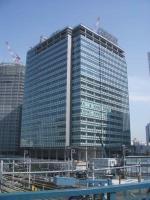
This 22-story office tower, scheduled for completion in January 2007, is rising in Osaki, a rapidly developing area along the southern portion of the JR Yamanote Line. Both the design and construction are being undertaken by Obayashi Gumi Corporation, a pioneer in environmentally friendly building materials and technologies. The total gross floor area will be 82,451 m2 with 2,785 m2 rentable area per standard floor. Retail spaces exist on the lower floors. Obayashi received much publicity for its efforts to achieve a zero emissions construction site through the reduction, sorting and recycling of construction waste and participation of all site workers in a program to minimize discharges and noise.
Art Village Osaki Central Tower highlights the best of Obayashi's green technologies. The windows feature "Low E Double Glazed Glass." Low E refers to low emissitivity whereby one side of a pane has a special metallic coating that reduces heat transfer. In winter the glass keeps the building warm by retaining internal heat, and in summer cool by reflecting external heat. "Double-glazed glass" refers to two sheets of glass with a layer of trapped air between them serving as insulation.
Obayashi's green tech is also evident in the HVAC (heating, airconditioning, ventilation and cooling) systems. These reduce power consumption through a range of technologies such as thermal storage systems, allowance for wide variation in temperature settings, quantity control for volume and flow, and utilization of natural ventilation.
Then there are the water, sewage and drainage systems. These incorporate water-saving and recycling technologies. The lighting systems automatically adjust in tandem with the window blinds to maximize utilization of natural light. Intelligent elevators regulate their voltage and frequency according to real-time demand.
Matsushita Electric Works Tokyo Headquarters Building
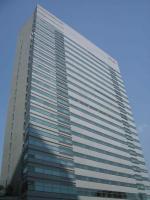
This 24-story building, located in the recently redeveloped Shiodome area, was built not only to display the many advanced and environmentally friendly technologies of Matsushita Electric Works, but also to act as a laboratory for testing new technologies as they are developed. Designed by Nikken Sekkei and constructed by Kajima Corporation, the building has a gross floor area of 47,308 m2 and was completed in January 2003.
Because the building is for its own use, Matsushita Electric Works was free to work with Nikken Sekkei to radically design a cutting-edge facility. In addition to many of the features incorporated in the above project, this building utilizes energy-conservation technologies such as photovoltaic cells to generate electricity from sunshine, a hybrid natural ventilation and HVAC system, and monitoring of the energy usage via an intranet. The HVAC units automatically control compressor and fan velocity load in order to operate smoothly with minimum power consumption.
What's more, rooftop greening and high levels of insulation reduce the external heat load.
A Building Energy Monitor System (BEMS) program is in place to serve as the point of contact for energy issues, problems, and costs. The success of a BEMS program requires up-front planning and development prior to implementation. However, the long-term payback of a well-planned program is well worth the invested time.
Meiji Yasuda Seimi Building
(Marunouchi My Plaza)
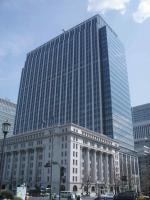
Completed in August 2004 and located in Marunouchi, Japan's most prestigious office district, this 30-story building, designed by Mitsubishi Jissho Sekkei and built by a Takenaka Corporation-Taisei Corporation joint venture, combines office and retail space. Total gross floor area is 147,134 m2 with 2,805 m2 rentable area per standard floor.
As the headquarters of the Meiji-Yasuda Life Insurance Company, and a high profile project for the companies involved, no effort was spared to ensure the building minimizes its impact on the environment.
Take, for example, the air-conditioning. On cool mornings, the building is "flushed" with outside air to rid accumulated heat before starting the air-conditioning system. In mild weather, the chillers are turned on later and off earlier. High-efficiency turbo freezers boost the energy efficiency of the air-conditioning, while CO2 emissions have been halved. The air-conditioning system cuts power usage in the same way that a computer-controlled car engine continually tunes and adjusts itself for optimum running efficiency. In the water system, rainwater is used in lavatories, humidifiers and airconditioning systems.
Finally, sensors inside the office space automatically detect and regulate brightness at desktop level and adjust window louvers for maximum natural light. Motion sensors extinguish lights in parts of the building that are used infrequently such as stairwells and hallways.
Conclusion
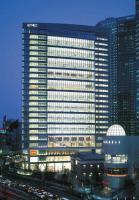
Office building developers and owners increasingly see their corporate mission as the realization of a society capable of sustainable development. They consider this an important management issue that will add value to tenants"companies. Accordingly, they are engaging in "coexistence with the environment" through establishing and maintaining effective environmental management systems. That is good for the environment. And good for business. I foresee a day when leading businesses will not move into a building that is not an IBEC award winner. JI
Case Studies
By reducing the environmental impact throughout the building life cycle from planning and design, to construction, operation, maintenance, and even dismantling, great benefits are realized by building owners, tenants and the larger community. The following case studies illustrate how green technologies and design were implemented by the forward-thinking developers of the above-mentioned office buildings, resulting in great savings in energy and running costs, and in improved corporate image.
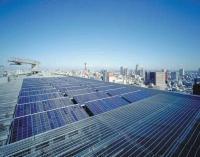
Catching some sun. The rooftop photovoltaic solar generation systems of the Matsushita Electric Works Tokyo Headquarter Building generate enough energy (10.5kW) to power an entire office floor.
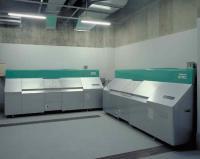
It's not what you have, but how you use it! Industrial Organic Waste Composting Units in the Matsushita Electric Works Tokyo Headquarter Building allow clean disposal of waste from the one thousand people who eat in the company cafeteria every day.
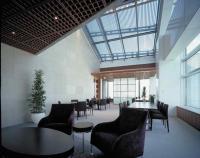
Imagine if your windows were made of a magical material that kept them clean forever! Photocatalytic coating materials on the exterior glass of the Matsushita Electric Works Tokyo Headquarter Building totally eliminate the need for cleaning.
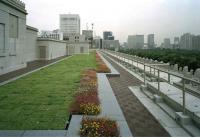
After completion of the Meiji Yasuda Seimei Building, the adjacent historic Meiji Seimiei Kan (1934) underwent renovation. Installation of new energy-saving air-conditioning allowed the rooftop to be cleared for a garden that helps reduce the "heat island effect."
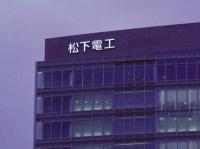
Tokyo's beautiful night skyline comes at a tremendous energy cost. The LED lighting sources used in the Matsushita Electric Works Tokyo Headquarter Building have twice the life and half the energy consumption of conventional neon lighting.

Dylan Robertson
Senior Associate, CBRE Consulting
CBRE Japan K.K.
Tel. +81-3-6230-1141
Email: dylan.robertson@cbre.co.jp
Website: www.cbre.co.jp
Dylan Robertson is one of the leading bilingual consultants advising major international occupiers and investors in the Japanese real estate market.






